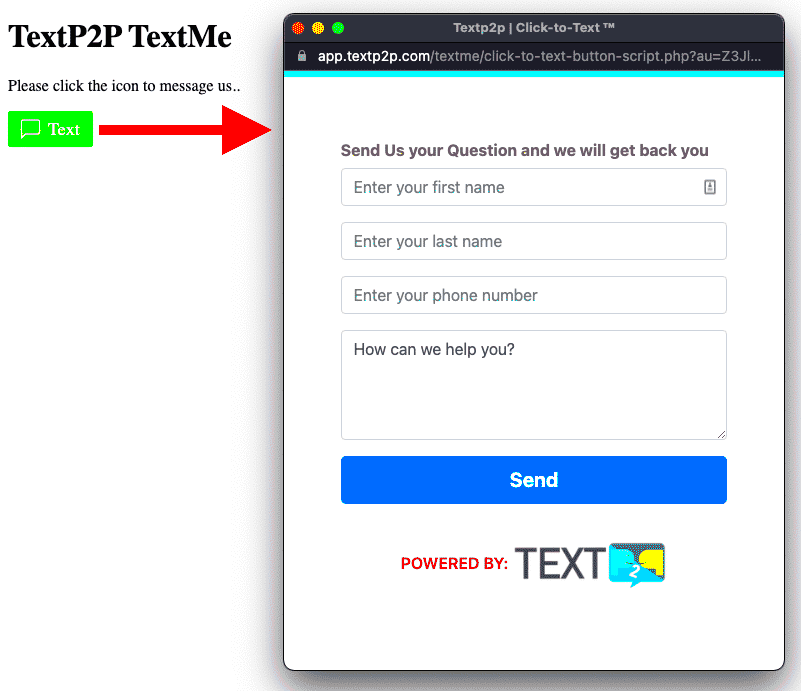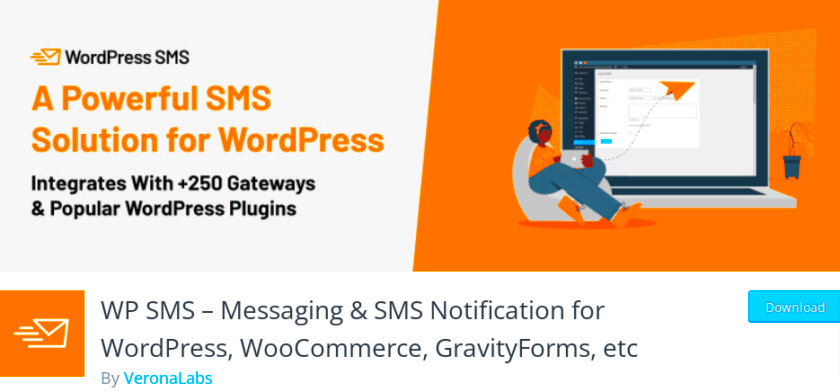In today’s fast-paced digital landscape, businesses are constantly seeking new ways to engage with their customers. One innovative solution gaining momentum is text messaging integration. By integrating SMS capabilities into your website, especially through a WordPress plugin, you can enhance your communication strategy, making it more streamlined and effective. Let’s explore the nuts and bolts of what text messaging integration is and how it can elevate your business interactions.
Benefits of Text Messaging for Businesses

Text messaging is more than just a convenient communication tool; it has become an essential part of customer engagement strategies for businesses of all sizes. Here are some key benefits:
- Instant Communication: Text messages are typically opened within minutes, allowing businesses to convey important information quickly.
- High Open Rates: Studies show SMS messages have a staggering open rate of 98%, compared to emails which average about 20%.
- Cost-Effective: Sending text messages is usually cheaper than traditional marketing channels, making it accessible for small businesses.
- Personalized Engagement: SMS allows businesses to send tailored messages based on customer preferences and behaviors, enhancing customer satisfaction.
- Improved Customer Service: Quick responses through SMS can resolve customer inquiries faster than waiting on hold for a call center.
To better illustrate these benefits, here’s a simple comparison of text messaging vs. other marketing channels:
| Channel | Open Rate | Engagement Speed | Cost |
|---|---|---|---|
| 20% | Minutes to Hours | Vary | |
| Social Media | 1-2% | Varies | Varies |
| Text Messaging | 98% | Seconds | Low |
As you can see, text messaging stands out as an incredibly effective tool for businesses looking to connect with their customers quickly and efficiently. By integrating SMS into your WordPress website, you’re not just keeping up with the trends; you’re setting the pace for better customer engagement.
Choosing the Right WordPress Plugin

When it comes to integrating text messaging services into your WordPress site, the choice of plugin is crucial. A well-suited plugin will not only enhance your site’s functionality but also improve user engagement and streamline communication. So, how do you go about making the right choice? Here are a few factors to consider:
- Compatibility: Ensure that the plugin is compatible with the latest version of WordPress and any other plugins you’re running. Some plugins are designed to work seamlessly with specific themes or configurations.
- User Reviews: Check customer feedback and ratings in the WordPress Plugin Directory. High ratings and positive reviews are a good indicator of reliability and functionality.
- Features: Different plugins offer varying features—some may focus solely on SMS services, while others might integrate with email or support other messaging platforms. Make a list of your must-have features before you start comparing.
- Customer Support: Look for plugins that offer robust customer support. Whether it’s through forums, live chat, or documentation, having access to support can save you time and headaches when issues arise.
- Pricing: Several text messaging plugins are available for free, while others come with premium features at a cost. Consider your budget, but also weigh the benefits of investing in a quality plugin.
Choosing the right WordPress plugin for text messaging integration is essential for enhancing your site’s communication capabilities. So take your time—do your research, and ensure you select a plugin that aligns with your goals!
Step-by-Step Guide to Integrate Text Messaging with WordPress

Getting your text messaging integration up and running might sound daunting, but with the right approach, it can be a breeze! Follow this step-by-step guide to ensure a smooth integration of text messaging into your WordPress site:
- Select Your Plugin: Begin by choosing the text messaging plugin that fits your needs. Weigh the compatibility, features, and reviews carefully.
- Install the Plugin: Once you’ve made your choice, navigate to your WordPress dashboard. Go to Plugins > Add New and search for your chosen plugin. Click Install Now and activate the plugin after installation.
- Configure Settings: After activation, you’ll find a new menu item in your dashboard for the plugin. Click on it and follow the setup wizard, where you’ll often need to enter your account details and API keys provided by your SMS service provider.
- Create Message Templates: If the plugin allows it, set up message templates that you’ll use frequently. This can save you time when sending messages.
- Test the Integration: Before launching to your audience, send a test message to ensure everything is working as expected. Check the formatting and delivery time.
- Utilize Features: Explore the additional features the plugin offers, like scheduling messages or automating replies. Make the most out of the functionalities available!
With these straightforward steps, you’ll have your text messaging system integrated with WordPress in no time. Happy messaging!
Customizing Your Text Messaging Settings
When it comes to integrating text messaging into your WordPress site, customization is key to ensuring that the communication resonates with your audience. After installing a text messaging plugin, you might feel a bit overwhelmed by the vast array of settings available. But don’t worry—it’s easier than it sounds!
First things first, let’s talk about your message templates. Most plugins will allow you to create customizable templates for various occasions, like promotional messages, appointment reminders, or even customer support communications. This not only saves you time but also ensures consistent branding. You can usually find these settings under a tab labeled “Templates” or “Messages.” Here’s a simple list of essential templates to consider:
- Promotional Offers
- Order Confirmations
- Appointment Reminders
- Customer Feedback Requests
Next, you’ll want to adjust the frequency and timing of your messages. Some plugins allow you to schedule messages to send at optimal times for your audience. This feature can dramatically increase your engagement rates. Check if your plugin offers a scheduling option and experiment with different times to see what works best!
Lastly, don’t forget to enable opt-in and opt-out features. It’s vital for maintaining a positive relationship with your audience. By allowing users to opt-in, you respect their privacy and legal regulations, leading to higher trust in your brand. All of these settings are usually accessible in the general configuration section of your plugin’s dashboard.
Best Practices for Text Messaging Communication
Text messaging is an incredibly effective communication tool when used properly. To ensure your messages are well-received and effective, consider these best practices:
- Keep it Short and Simple: Since text messages have a character limit, make sure your messages are concise. Aim for clear, direct language that conveys the essential information without fluff.
- Personalize Your Messages: Whenever possible, use the recipient’s name and tailor the message based on their preferences or past interactions. A personalized message is much more likely to engage your audience!
- Timing is Everything: Avoid sending messages too early in the morning or late at night. Aim for mid-morning or early afternoon when recipients are more likely to be receptive.
- Include a Clear Call to Action (CTA): Whether you want users to click a link, reply to the message, or visit your site, make sure to include a clear and compelling CTA.
- Monitor and Analyze: Use analytics tools to track open rates, click rates, and overall engagement. This data will help you refine your messaging strategy over time.
By following these best practices, you can ensure that your text messaging efforts are not just effective but also a delightful experience for your audience. Remember, the goal is to foster an open line of communication—one that adds value and enhances your relationship with your customers.
Common Challenges and Troubleshooting Tips
Integrating text messaging into your WordPress website can be a game-changer, but it’s not without its hurdles. It’s essential to recognize these challenges early so you can navigate through them smoothly. Here are some common issues and valuable troubleshooting tips:
- API Connectivity Issues: Sometimes, the connection between your WordPress site and the text messaging service can be problematic. Ensure that your API keys are correctly set up. A simple typo can break the integration.
- Plugin Conflicts: If you have multiple plugins running, there’s a chance they might interfere with each other. To troubleshoot, deactivate other plugins temporarily and see if the text messaging feature works. Re-activate them one by one to identify the conflicting plugin.
- Incorrect Settings Configuration: Review your settings carefully. In many cases, a wrong setting can lead to failure in sending or receiving messages. Double-check your account information, SMS gateway, and webhook URLs.
- Delivery Issues: Messages might not be delivered due to network restrictions or compliance issues. Check with the service provider regarding any limitations or guidelines you need to follow.
- Insufficient Testing: Before going live, ensure you test the integration thoroughly. Use different devices and numbers to test the full range of functionalities.
- Too Many Requests Error: If you’re sending bulk messages, you might hit rate limits imposed by your provider. It’s crucial to understand your provider’s sending limits and adjust your campaign accordingly.
By being aware of these challenges and proactively addressing potential issues, you’ll create a seamless experience for your users. Remember, troubleshooting is part of the process, so don’t hesitate to reach out to support channels when needed!
Case Studies: Success Stories of Text Messaging Integration
Text messaging integration has proven to be a pillar of success for many businesses. Let’s dive into a couple of noteworthy case studies that illustrate just how impactful this technology can be:
| Business | Challenge | Solution | Results |
|---|---|---|---|
| Local Restaurant | Low customer engagement | Integrated SMS reminders for reservations | Increased reservations by 40% |
| E-commerce Store | High cart abandonment rates | Implemented cart recovery SMS alerts | Reduced cart abandonment by 30% |
| Non-Profit Organization | Difficulties with event participation | Used SMS campaigns for event reminders | Boosted event attendance by 50% |
In these case studies, each business faced unique challenges that were strategically addressed through text messaging integration. The results speak volumes—not only did they enhance customer engagement, but they also significantly improved their operational efficiency. The takeaway? Text messaging isn’t just an add-on; it’s a transformative tool that can drive growth and enhance communication. With the right approach, your business could be the next success story!
Website HTML for Text Messaging Integration with WordPress Plugin
Text messaging has become a vital communication tool for businesses looking to engage with their customers effectively. By integrating text messaging capabilities into your WordPress website, you can foster better interactions, streamline notifications, and enhance customer service. This guide will walk you through the essential components and steps involved in integrating text messaging into your WordPress site.
Here are some key benefits of using text messaging integration:
- Instant Communication: SMS provides real-time communication, ensuring your messages reach customers immediately.
- High Open Rates: Text messages have a significantly higher open rate compared to emails, making them an effective marketing tool.
- Improved Customer Experience: Quick responses and updates lead to higher customer satisfaction and loyalty.
- Automation: Automate alerts, reminders, and notifications to save time and reduce manual effort.
To implement text messaging integration on your WordPress site, follow these steps:
- Choose a Text Messaging Service: Select a reliable SMS gateway provider, such as Twilio or Nexmo.
- Install a WordPress Plugin: Look for a plugin that supports SMS functionality like WP SMS or SMS Notifications.
- Configure Plugin Settings: Enter your API credentials and adjust settings as per your messaging needs.
- Customize Message Templates: Design text messages to align with your branding and customer interactions.
- Test the Integration: Send test messages to ensure everything functions smoothly.
By following these steps, you can successfully integrate text messaging into your WordPress site, making it easier to connect with your audience and enhance their overall experience.
Conclusion: Enhance Your Engagement with Text Messaging
Integrating text messaging into your WordPress website is a powerful strategy to enhance engagement, streamline communication, and foster better relationships with your customers.



